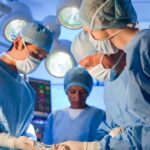The procedure of haemorrhoids removal It is called HPS, a technique that consists in the application of sutures with the aim of bringing the “pads” back into the anal canal, without any surgical wound.
Proctologist surgeon Nicola Cracco illustrates the operation. It is a disorder that is not readily spoken of, but it is very common from the age of 20-25, in both sexes, although pregnancy and childbirth increase the risk in women.
They are hemorrhoids, an anatomical term – which defines the vascular cushions of the anal canal, formed by arteries and veins, which have the physiological function of assisting fecal continence – but which is used to indicate a pathological state when they become “symptomatic “, That is when they cause a disturbance.
When they become pathological
“First of all, hemorrhoids become pathological when they undergo prolapse (ie the leakage from their natural site with or without the need for manual reduction) and / or bleeding. However, in these cases they are not painful ”, explains Dr. Nicola Cracco, head of proctological surgery. “They become such only if they are thrombosed, that is, if blood clots form inside, and then harden making it impossible to reduce the prolapse”.
Haemorrhoids removal, two intervention techniques compared
In these cases, depending on the extent of the discomfort experienced by the patient due to the prolapse and / or the presence of habitual bleeding (unresponsive to medical therapy) that can cause anemia, surgical treatment is required. The Haemorrhoids removal (hemorrhoidectomy) is the oldest surgery and also the one that guarantees the best long-term results.
“This is an operation that arouses fear in the patient as it is painful and that requires a few weeks of convalescence – explains Dr. Cracco -. But it is not the only one we have available, because for some years the HPS (Hemorpex System) technique has been consolidated, absolutely painless, effective and which allows a quick return to daily activities ”.

Haemorrhoids removal, sutures instead of scars
“The Haemorrhoids removal surgical technique consists in the application of sutures upstream of the hemorrhoids, that is, in the rectum, which have the purpose of bringing the” cushions “back into the anal canal. It is a conservative intervention, the hemorrhoids are not removed, and therefore not painful “, explains Dr. Cracco.
“It is a technique that works and above all does not cause damage. What we do not yet know are the long-term results, as being a relatively recent modality of intervention, we do not have sufficient medical-scientific literature to quantify them ”.
Hemorrhoids can reform themselves
In fact, even if removed, hemorrhoids can reform. A very low recurrence rate has been reported for hemorrhoidectomy, around 5% at 5 years – explains Cracco -. In fact, it can happen that once removed from their classic locations (one on the left and two on the right), the hemorrhoids reappear. On the recidivism rate after HPS, on the other hand, we cannot say anything yet ”.
Prevention: drink lots of water
Can hemorrhoid prolapse and bleeding be prevented? “The main prevention consists in a varied diet rich in fiber and with an abundant supply of liquids. This helps to keep the stool soft, thus avoiding the risk of prolapse caused by the effort of evacuation and bleeding.
As for food, there is an axiom that chocolate, coffee and spicy foods cause damage to hemorrhoids. But it is not always true, it may be true for some people and not for others ”, concludes Dr. Cracco.






